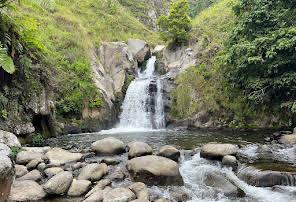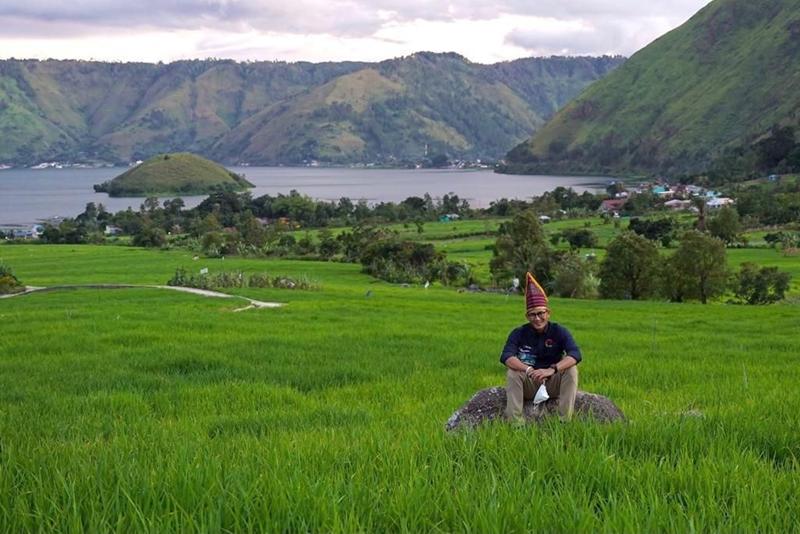On the far side of Lake Toba, where the hills roll down into rice terraces and the air smells of fresh earth and pine, you’ll find a quiet village that seems to pause time—Tipang, in Baktiraja, North Sumatra.
It’s not a tourism hotspot (yet), but those who’ve visited will tell you: Tipang isn’t just a beautiful village—it’s a spiritual and cultural oasis that holds some of the deepest roots of Batak tradition. It has legends. It has sacred sites. And most of all, it has a deep sense of harmony between humans, land, and the divine.
🗺️ Where Is Tipang?
Tipang is part of the Baktiraja District in Humbang Hasundutan Regency, North Sumatra. It sits quietly by the southern edge of Lake Toba, not far from the more well-known Bakkara Valley. To reach it from Dolok Sanggul (the capital of the regency), it takes about 2 to 2.5 hours by road—less if you’re staying near Bakkara.
What makes the journey special is the final stretch: winding roads flanked by terraced rice fields, pine forests, and distant views of the blue-gray lake meeting the sky.
🧬 Historical & Cultural Significance
Tipang is often cited as one of the original settlements of the Batak people—especially the Marga Simamora, one of the Batak clan lineages. It holds a significant place in oral traditions, genealogy stories, and spiritual customs. Many Batak family trees trace their roots back to this very place.
In Batak cosmology, places like Tipang are seen as “Tanah Awal”—the origin land, where humans first communed with the spirits, nature, and ancestors. This gives the village a kind of quiet reverence. It’s not loud or flashy—but it feels sacred.
🌿 What Makes Tipang Unique?
1. Sacred Sites and Ritual Areas
Tipang is dotted with traditional Batak structures like sopo (rice barns), ruma bolon (longhouses), and small sacred spots often tied to pustaha (ancient knowledge) or local adat (customary law). Ritual stones and ancestral sites are still protected and respected by the community.
If you walk with a local guide, they’ll tell you where “raja parhata” (ritual elders) used to meet, or where adat vowswere made under old trees by the riverside.
2. Tipang Waterfall (Sampuran Tipang)
A short walk from the village brings you to a beautiful, lesser-known waterfall often called Sampuran Tipang. It’s modest in height but majestic in its setting, flowing through rocks surrounded by bamboo and forest canopy. The water is incredibly clean—locals believe it to be spiritually cleansing.
3. Agricultural Richness
The village thrives on farming and fishing, especially onions, rice, and freshwater tilapia from the lake. With its fertile volcanic soil and constant access to fresh water, Tipang is a model for sustainable rural living—where modern agricultural practices blend with traditional wisdom.
4. Views, Views, Views
This is not an exaggeration: Tipang has some of the best natural viewpoints over Lake Toba. You can see dramatic cliffs dropping into the lake, sunlight breaking over misty hills, and terraced fields glowing green under golden hour light. It’s a photographer’s dream, and an ideal place for slow travel.
🛕 Living Tradition: Adat Still Thrives Here
Unlike more urbanized Batak areas, Tipang still lives and breathes adat (traditional law). Ceremonies, clan meetings, and spiritual rituals are still held with full protocol—complete with ulos cloths, gondang sabangunan music, and offerings to Debata (the divine).
Visitors who come respectfully are sometimes invited to witness or even participate in cultural ceremonies, especially during horja bius (village ritual festivals). These moments are extremely rare to find in modern Indonesia and offer a powerful window into living heritage.
💡 Why Tipang Should Be On Your Radar
Tipang represents a unique blend of:
-
Pristine Nature (clean rivers, forests, and lake access)
-
Living Culture (authentic Batak ceremonies, architecture, and values)
-
Spiritual Depth (ancestral land, origin stories, sacred sites)
-
Untapped Tourism Potential
But here’s the thing: Tipang doesn’t need to be turned into a noisy resort town. It’s perfect for eco-tourism, spiritual retreats, ethnographic tourism, or cultural residencies for artists and storytellers. The community is warm, the environment is gentle, and the pace of life invites reflection.
✨ Final Thoughts: Tipang Is Not Just a Village—It’s a Portal
In a world rushing toward modernity, Tipang is the kind of place that slows you down—not because there’s nothing to do, but because everything here feels meaningful. The land is alive with stories. The people carry history in their names. And every stream, tree, and stone seems to hold a secret if you take the time to listen.
If you ever find yourself wandering the lesser-touched corners of Lake Toba, don’t miss Tipang. Go with respect. Listen to the elders. Drink the water. Walk slowly. Because in Tipang, you’re not just visiting a village—you’re stepping into the roots of an entire civilization.


